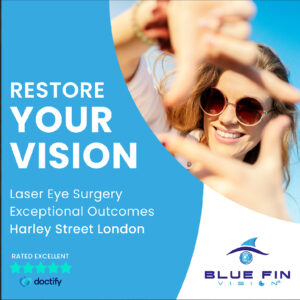From Consultation to Recovery: What to Expect from Refractive Lens Exchange
Refractive Lens Exchange (RLE) has become an increasingly popular and highly effective option for those seeking long-term vision correction. As people age, vision problems related to refractive errors, presbyopia, or cataracts often emerge, and these conditions may become difficult to manage with traditional solutions like glasses or contact lenses. RLE offers an alternative by replacing the eye’s natural lens with a specially selected intraocular lens (IOL), providing permanent correction for a wide range of vision problems. It is especially beneficial for those over 40, who are often facing age-related vision issues that cannot be effectively treated with laser surgery like LASIK.

Presbyopia, which typically begins in the early 40s, is one of the most common age-related vision conditions that RLE addresses. People with presbyopia experience difficulty focusing on close objects, making tasks like reading or sewing challenging without reading glasses. RLE with multifocal or accommodating IOLs can restore the eye’s ability to focus on both near and far objects, reducing or completely eliminating the need for reading glasses or bifocals. The ability to see clearly at multiple distances is a major reason RLE is often preferred over other corrective surgeries, especially as people want to avoid the inconvenience of constantly changing glasses or lenses for different activities.
For those with cataracts, RLE offers an all-in-one solution. Cataracts occur when the natural lens of the eye becomes cloudy, leading to blurry vision. In traditional cataract surgery, the clouded lens is removed and replaced with a standard IOL to restore clarity. However, with RLE, the lens is replaced with an IOL that not only corrects the cataract but also addresses refractive errors such as myopia or hyperopia, providing the patient with better overall vision. In fact, many people who undergo RLE for cataracts end up with improved vision that they hadn’t expected, as the new IOL offers better focus and clarity compared to their original lens.
One of the primary benefits of RLE over LASIK or other laser vision correction procedures is that it is more suitable for people with certain limitations. While LASIK is ideal for those with stable corneas and refractive errors, it is not recommended for individuals who are over 40, have high degrees of refractive errors, or suffer from conditions like dry eye Refractive lens exchange or thin corneas. In contrast, RLE involves removing and replacing the natural lens, meaning it can be used to treat a much broader range of vision problems. This makes it a viable option for people who would otherwise be disqualified from LASIK surgery.
The RLE procedure itself is relatively quick, usually taking between 15 to 30 minutes per eye. It is performed on an outpatient basis under local anesthesia, so patients remain awake but relaxed during the surgery. The surgeon makes a small incision in the cornea, removes the natural lens, and replaces it with the appropriate IOL. Thanks to advancements in surgical techniques, including the use of femtosecond lasers and microincision technology, the procedure is minimally invasive with a very low risk of complications. Most patients report only mild discomfort during recovery, and the healing process is typically quick, allowing individuals to resume their daily activities in a short amount of time.
However, as with any surgical procedure, RLE carries some risks. While complications are rare, they can include infection, inflammation, or changes in vision that might require follow-up treatments or adjustments. In some cases, patients might experience visual disturbances such as glare or halos around lights, particularly at night. These symptoms are typically temporary and resolve as the eye adjusts to the new lens. Additionally, in some instances, the IOL may shift slightly, requiring repositioning. Fortunately, these types of complications are uncommon, and most patients experience significant improvements in their vision within weeks of surgery.
The cost of RLE can be higher than traditional cataract surgery or LASIK, primarily because of the specialized technology used to create and implant the custom IOLs. While LASIK typically involves reshaping the cornea to correct refractive errors, RLE is a more comprehensive procedure that not only corrects refractive issues but also addresses age-related lens changes. As a result, the cost can reflect the level of customization needed for each patient’s vision requirements. However, for many individuals, the benefits of RLE far outweigh the expense. By eliminating the need for glasses or contact lenses, patients often find that the procedure offers long-term savings, especially since it typically provides lifelong results.
Another factor to consider when undergoing RLE is the selection of the appropriate IOL. There are various types of IOLs, including monofocal lenses, which provide clear vision at a single distance, and multifocal lenses, which allow for clear vision at near, intermediate, and far distances. There are also toric lenses designed for patients with astigmatism. The type of IOL chosen depends on the patient’s individual needs and lifestyle, making it essential for patients to have a thorough consultation with their ophthalmologist before the procedure. The right choice of IOL can significantly impact the quality of vision post-surgery.
In addition to its ability to correct refractive errors, presbyopia, and cataracts, RLE also provides patients with greater freedom from glasses or contacts. For many people, the desire to live an active lifestyle without the hassle of corrective eyewear is a key motivator for seeking out RLE. Whether it’s enjoying outdoor activities, participating in sports, or simply reading or driving without needing glasses, the improved vision that RLE provides can lead to a better overall quality of life.
In conclusion, Refractive Lens Exchange is a highly effective and versatile procedure that offers long-lasting benefits for individuals struggling with refractive errors, presbyopia, or cataracts. It provides patients with the ability to achieve clearer vision without relying on glasses or contact lenses and is an excellent solution for those over 40 who have vision issues that cannot be corrected with LASIK or other traditional methods. By addressing both refractive errors and age-related vision changes in one procedure, RLE can greatly enhance quality of life and restore a sense of freedom in daily activities. As with any surgery, it’s important for individuals to consult with an experienced ophthalmologist to determine if RLE is the right choice based on their specific vision needs and lifestyle.…






